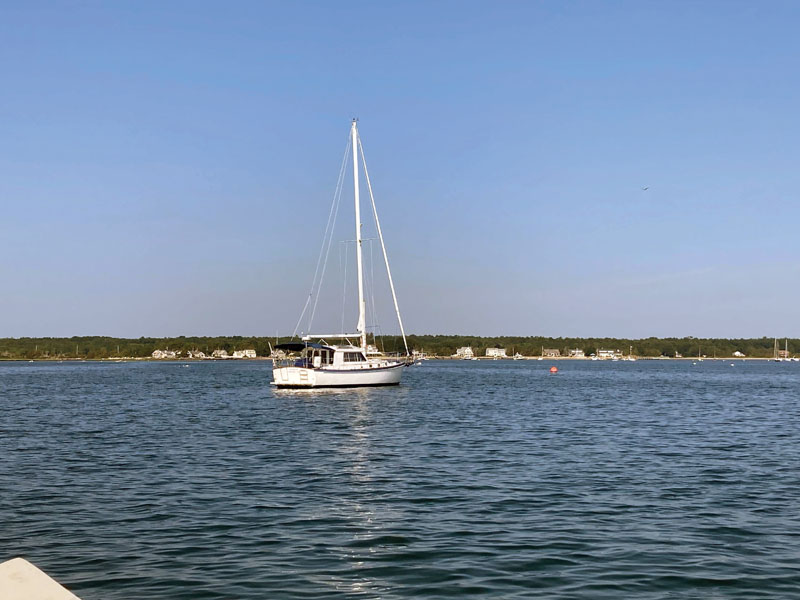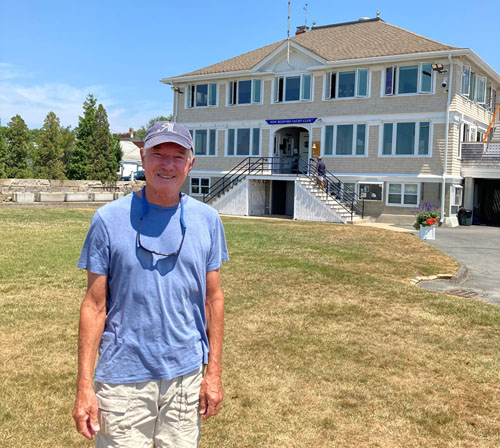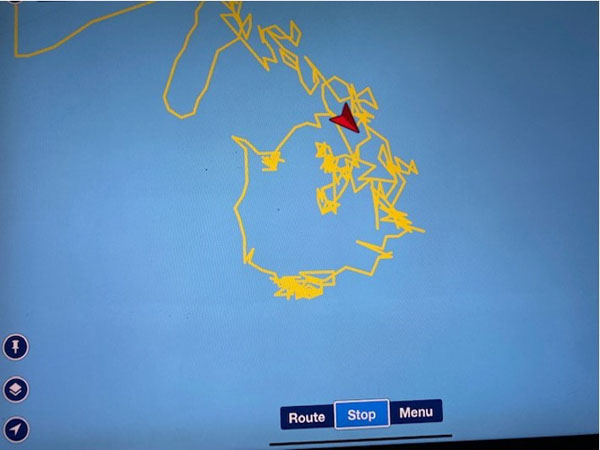A sailing trip up the East Coast
In mid-June I left my home port of Oxford, MD, heading for the cooler climes of New England. My crew and I were sailing up the East Coast on our Cabo Rico NE400 Adagio. It was a pleasant trip, stopping in Sag Harbor, NY, Block Island and Newport, RI, Marion, MA, and finally, Mattapoisett, MA. Compared to all the previous ports with crowded mooring fields, Mattapoisett Harbor is wide open with often hundreds of feet between moorings, which makes it a pleasant place to relax and enjoy the view of owners and borrowers sailing up to their moorings.

Sailing home was uneventful until...
At the end of July, it was time to return to the Chesapeake, so a friend joined me in Newport to crew for the trip home. The trip was uneventful until Cape May, NJ. We arrived around 6 p.m. and dropped anchor in the company of several other boats in the usual spot outside the Coast Guard Station. Over dinner we discussed the next day’s transit up the Delaware Bay. We had both done this leg many times and commented on how difficult it is to get a fair current all the way up the bay. We certainly didn’t want to waste time fighting the notoriously strong current.
Consulting our “Eldridge Tide & Pilot,” we determined the current change at Delaware Bay entrance would be at 9:15 a.m. and decided we would get the anchor up promptly at seven in order to be at the entrance to the Bay around 9 a.m. The forecast for Thursday, August 4 was favorable, with 10 to 15 knots from the south, which would put us at the C & D Canal around 4:30 p.m. We planned our next anchorage in Bohemia Bay for about 7:30 that evening.
Our only concern was that the forecast included severe thunderstorms in the vicinity of Bohemia Bay, starting around 7 p.m. We briefly considered other choices to stop overnight, such as Summit North Marina or Chesapeake City Basin. However, both are too shallow for my draft of nearly five feet, so we were committed to the Bohemia Bay area.

The kindess of strangers
As we began the process of pulling up anchor to leave that Thursday morning, the windlass was having trouble bringing up the anchor. We tried to troubleshoot in the usual ways. We saw the problem: there was a piece of thoroughly waterlogged four-by-six-inch lumber, 10 feet long, snagged in the anchor line!
The anchor chain had completely wrapped around the log and would not let go. I did not have a dinghy with me for the trip since most of the moorings in New England provide launch services, so dealing with the log solely from the bowsprit was going to be a challenge. After trying to loosen it with lines, boathooks, and other experimental methods, we finally hailed a small passing fishing boat for assistance. With their help and working from the waterline, they were able to maneuver its release. Thank goodness for the kindness of strangers!
Unfortunately, we had spent more than two hours on this effort and were now concerned about getting to our destination before the bad weather would hit. I looked at the Cape May Canal Bridge, and with the added pressure of time, wondered if we could make it. The bridge there is 55 feet, and the tide was down five feet. My mast measures 58 feet tall, and VHF antenna another two feet—could I make it and save almost two hours? I decided against it. We took off to the inlet prior to heading around Cape May Point, only to find our next obstacle: heavy fog.
It slowed us down for a while, but the fog burned off by 11 a.m. The south wind filled in as promised. As time passed, the forecast for evening storms was getting more specific. Based on the major storms the night before that ravaged the Western and Eastern Shores of the Chesapeake, it looked like getting caught in a nasty storm was unavoidable. As luck would have it, the current and wind were better than expected. We managed to average over nine knots the entire way up Delaware Bay, getting to the C & D Canal at 4 p.m. just in time for the favorable current westbound.
The race was on!
Once in the canal, our ETA for the Bohemia was 7 p.m. and radar showed the large storm cells arriving around 7:30. The race was on! Bohemia Bay is very shallow, most of it just five to eight feet deep. While this is good for anchoring, it’s not so good for wave action in a storm, as it is wide open to the west.
At 7:15 the anchor was down with 115 feet of three-eighths-inch chain in six feet of water. I was rigging the snubber when the first tendrils of cold wind came from the west. Minutes after that it blew 45 knots with a lot of short, steep waves and heavy rain. I left the anemometer on so that we wouldn’t have to guess or exaggerate. The 45 knot winds continued for about 20 minutes. During that time, I had to use the engine to keep the bow into the wind and keep the pressure off the anchor as much as possible.
Sailors know the force of the wind is equal to the square of the wind speed. This is not some arcane mathematical formula—it is very relevant. Knowing that 20 knots is almost double the force of 15 knots, it is easier to understand why most sailors reef at 18 knots. The force of the wind at 45 knots is nine times the force at 15 knots. On that Thursday evening, we felt every bit of it.
Lightning strikes were frequent all around us for over an hour. Eventually, the 45 knot winds slowed to 35 for another 20 minutes and to 25 for half an hour. After that, it settled down to 15 knots for a while, which felt like flat calm in comparison. The inside steering station in my Cabo Rico was a real benefit in this situation. The cockpit helm would have been very wet and cold on many other sailing vessels.

For the duration of the storm the boat moved erratically as the wind shifted. I was able to capture the boat’s movements during the storm on my plotter. The GPS paints an interesting picture.
So, from an unusual anchor delay to the fastest transit of Delaware Bay I have made to date, to a powerful storm system arriving just minutes after setting the anchor, this was an exciting day on the water to remember!
by Neil Ross, member of The Corinthians Chesapeake Bay Fleet




